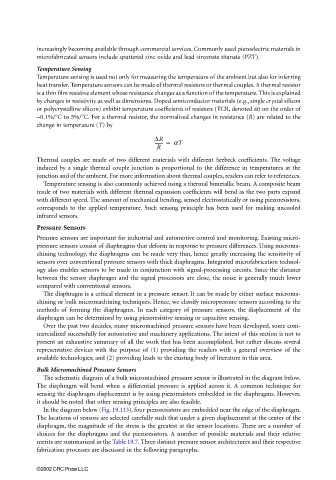Page 518 - The Mechatronics Handbook
P. 518
0066_frame_C19 Page 140 Wednesday, January 9, 2002 5:32 PM
increasingly becoming available through commercial services. Commonly used piezoelectric materials in
microfabricated sensors include sputtered zinc oxide and lead zirconate titanate (PZT).
Temperature Sensing
Temperature sensing is used not only for measuring the temperature of the ambient but also for inferring
heat transfer. Temperature sensors can be made of thermal resistors or thermal couples. A thermal resistor
is a thin film resistive element whose resistance changes as a function of the temperature. This is explained
by changes in resistivity as well as dimensions. Doped semiconductor materials (e.g., single crystal silicon
or polycrystalline silicon) exhibit temperature coefficients of resistors (TCR, denoted α) on the order of
−0.1%/°C to 5%/°C. For a thermal resistor, the normalized changes in resistance (R) are related to the
change in temperature (T) by
∆R
------- = aT
R
Thermal couples are made of two different materials with different Seebeck coefficients. The voltage
induced by a single thermal couple junction is proportional to the difference in temperatures at the
junction and of the ambient. For more information about thermal couples, readers can refer to references.
Temperature sensing is also commonly achieved using a thermal bimetallic beam. A composite beam
made of two materials with different thermal expansion coefficients will bend as the two parts expand
with different speed. The amount of mechanical bending, sensed electrostatically or using piezoresistors,
corresponds to the applied temperature. Such sensing principle has been used for making uncooled
infrared sensors.
Pressure Sensors
Pressure sensors are important for industrial and automotive control and monitoring. Existing micro-
pressure sensors consist of diaphragms that deform in response to pressure differences. Using microma-
chining technology, the diaphragms can be made very thin, hence greatly increasing the sensitivity of
sensors over conventional pressure sensors with thick diaphragms. Integrated microfabrication technol-
ogy also enables sensors to be made in conjunction with signal-processing circuits. Since the distance
between the sensor diaphragm and the signal processors are close, the noise is generally much lower
compared with conventional sensors.
The diaphragm is a critical element in a pressure sensor. It can be made by either surface microma-
chining or bulk micromachining techniques. Hence, we classify micropressure sensors according to the
methods of forming the diaphragms. In each category of pressure sensors, the displacement of the
diaphragm can be determined by using piezoresistive sensing or capacitive sensing.
Over the past two decades, many micromachined pressure sensors have been developed, some com-
mercialized successfully for automotive and machinery applications. The intent of this section is not to
present an exhaustive summary of all the work that has been accomplished, but rather discuss several
representative devices with the purpose of (1) providing the readers with a general overview of the
available technologies; and (2) providing leads to the existing body of literature in this area.
Bulk Micromachined Pressure Sensors
The schematic diagram of a bulk micromachined pressure sensor is illustrated in the diagram below.
The diaphragm will bend when a differential pressure is applied across it. A common technique for
sensing the diaphragm displacement is by using piezoresistors embedded in the diaphragms. However,
it should be noted that other sensing principles are also feasible.
In the diagram below (Fig. 19.113), four piezoresistors are embedded near the edge of the diaphragm.
The locations of sensors are selected carefully such that under a given displacement at the center of the
diaphragm, the magnitude of the stress is the greatest at the sensor locations. There are a number of
choices for the diaphragms and the piezoresistors. A number of possible materials and their relative
merits are summarized in the Table 19.7. Three distinct pressure sensor architectures and their respective
fabrication processes are discussed in the following paragraphs.
©2002 CRC Press LLC

